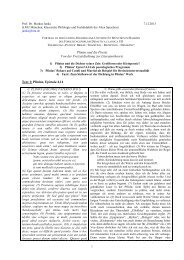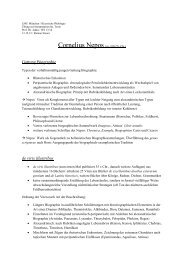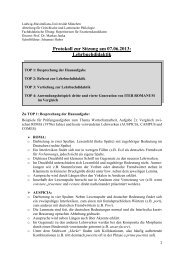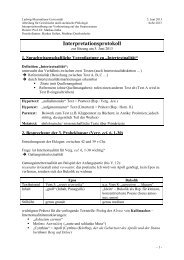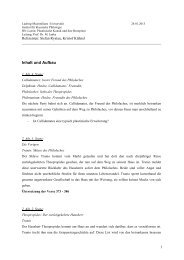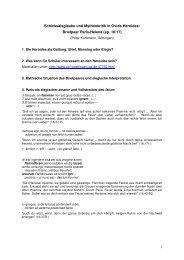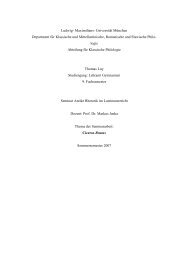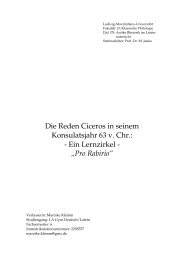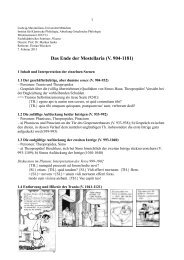PDF-Dokument öffnen
PDF-Dokument öffnen
PDF-Dokument öffnen
Create successful ePaper yourself
Turn your PDF publications into a flip-book with our unique Google optimized e-Paper software.
Ovid, Amores: Bibliographie<br />
Ausgaben / Kommentare / Übersetzungen<br />
Albrecht, Michael (1997): Ovid: Amores. Liebesgedichte. Lateinisch/Deutsch. Übersetzt und<br />
herausgegeben. Universal-Bibliothek 1361 (Stuttgart).<br />
Barsby, John A. (1973): Ovid’s Amores, Book One (Oxford; reprint Bristol, 1979).<br />
Booth, John (1991): Ovid: The Second Book of Amores. Edited with Translation and<br />
Commentary (Warminster; 2 2000).<br />
Brandt, Paul (1911): P. Ovidi Nasonis Amorum libri tres (Leipzig; reprint Hildesheim, 1991).<br />
Goold, George Patrick (1977): Ovid I: Heroides and Amores. With an English Translation by<br />
Grant Showerman. Second Edition Revised by –. Loeb Classical Library (Cambridge,<br />
Mass./London).<br />
Green, Peter (1982): Ovid: The Erotic Poems: The Amores, The Art of Love, Cures for Love,<br />
On Facial Treatment for Ladies. Penguin Classics (Harmondsworth).<br />
Harder, Richard/Walter Marg (1956): P. Ovidius Naso, Liebesgedichte. Amores. Lateinisch<br />
und deutsch (München; 7 1992).<br />
Holzberg, Niklas (1999): Publius Ovidius Naso: Liebesgedichte. Amores. Lateinisch-deutsch.<br />
Herausgegeben und übersetzt. Sammlung Tusculum (Düsseldorf/Zürich; Studienausgabe<br />
ibid. 2002).<br />
Holzberg, Niklas (2004; ed.): Applaus für Venus. Die 100 schönsten Liebesgedichte der<br />
Antike. Ausgewählt und übersetzt (München).<br />
Kenney, Edward John (1961; ed.): P. Ovidi Nasonis Amores Medicamina faciei femineae Ars<br />
amatoria Remedia amoris. Scriptorum Classicorum Bibliotheca Oxoniensis (Oxford;<br />
reprinted from corrected sheets of the first edition 1965; iteratis curis edidit 1994).<br />
Lee, A. Guy (2000): Ovid in Love: Ovid’s Amores, Translated by – and with Drawings by<br />
John Ward (London).<br />
Lenz, Friedrich Walter (1965): Ovid: Die Liebeselegien. Lateinisch und Deutsch. Schriften<br />
und Quellen der Alten Welt 15 (Berlin; 3., neu bearbeitete Auflage von Mali G. Lenz, ibid.<br />
1976).<br />
McKeown, James (1987/89/98): Ovid: Amores. Text, Prolegomena and Commentary in Four<br />
Volumes. I. Text and Prolegomena. II: A Commentary on Book One. III: A Commentary on<br />
Book Two. Arca 20.22.36 (Leeds).<br />
Miller, Paul Allen (2002; ed.): Latin Erotic Elegy: An Anthology and Reader. Edited with an<br />
Introduction and Commentary (London/New York).
Némethy, Geyza (1907): P. Ovidii Nasonis Amores. Editiones criticae scriptorum Graecorum<br />
et Romanorum a collegio philologico classico Academiae Litterarum Hungaricae publici<br />
iuris factae (Budapestii).<br />
Ramírez de Verger, Antonio (2003): P. Ovidius Naso: Carmina amatoria. Amores.<br />
Medicamina faciei femineae. Ars amatoria. Remedia amoris. Bibliotheca scriptorum<br />
Graecorum et Romanorum Teubneriana (München/Leipzig).<br />
Ramírez de Verger, Antonio/Socas, Francisco (1991; edd.): Publio Ovidio Nasón: Obra<br />
amatoria I: Amores (Madrid).<br />
Abhandlungen<br />
Ahern, Charles Frederic, jr. (1983): Ovidius ludens: Poetry, Love and the Opposition of<br />
Nature and Culture in the Amatory Poems (diss., Yale University, New Haven, Conn).<br />
– (1987): “Ovid, Amores 2.7.27 f.”, CJ 82, 208-9.<br />
Albrecht, Michael (1976): “Qua arte narrandi Ovidius in Amoribus usus sit”, in Acta 1976,<br />
57-63.<br />
– (1977): Römische Poesie. Texte und Interpretationen (Heidelberg; Tübingen 2 1995 = UTB<br />
1845).<br />
– (1998): “Umgangssprachliche Elemente in Ovids Amores”, in Baumbach, Manuel/Köhler,<br />
Helga/Ritter, Adolf Martin (edd.): Mousopolos Stephanos: Festschrift für Herwig<br />
Görgemanns. Bibliothek der klassischen Altertumswissenschaften N. F. 2. Reihe, 102<br />
(Heidelberg), 20-42.<br />
– (2000b): “Ovids Amores und sein Gesamtwerk”, WS 113, 167-80 = “Los Amores de<br />
Ovidio y el conjunto de su obra”, Myrtia 16, 2001, 173-85.<br />
Alfonsi, Luigi (1959): “Amores II, 16, 11-12”, Latomus 18, 800-2.<br />
– (1976): “L‟humanitas di Ovidio negli Amores”, in Acta 1976, 71-8.<br />
Allen, Peter L. (1984): Love Oft Expressed: Conventions and Irony in Ovid’s Amores,<br />
Aucassin and Nicolette, and Chaucer’s Legend of Good Women (diss., The University of<br />
Chicago, Chicago, Ill.).<br />
Almirall Sardà, Jaume (1995): “Amor i navegació. Transsumptes de la poesía en els Amores<br />
d‟Ovidi”, Faventia 17, 39-48.<br />
Arcaz Pozo, Juan Luis (1992): Las obras amatorias de Ovidio en los manuscritos de España.<br />
Col. Tesis doctorales 38/92 (Madrid).<br />
– (1993b): “Los tituli de las elegías de los Amores de Ovidio en el ms. Escorialensis g.<br />
III.26”, Habis 24, 125-32.<br />
– (1994): “Hurtado de Mendoza, traductor de Ovidio: Amores I 5 y 8”, in Actas del VIII<br />
congreso español de estudios clásicos (Madrid, 23-28 de septiembre de 1991) (Madrid),<br />
III, 349-56.<br />
– (1995): “Passer mortuus est! Catulo (carm. 3), Ovidio (am. 3.7) y Maximiano (el. 5.87-<br />
104)”, CFC(L) 8, 79-88.<br />
– /Laguna Mariscal, Gabriel/Ramírez de Verger, Antonio (1996; edd.): La obra amatoria di<br />
Ovidio: aspectos textuales, interpretación literaria y pervivencia (Madrid).
Arkins, Brian (1990): “The Anxiety of Influence: Ovid‟s Amores as , Latomus 49,<br />
826-32.<br />
Athanassaki, Lucia (1992): “The Triumph of Love and Elegy in Ovid‟s Amores 1, 2”, MD 28,<br />
125-41.<br />
Baeza Angulo, Eulogio F. (1989): “Ovidio, Amores III, 7”, Faventia 11, 25-58.<br />
Baker, Robert J. (1973): “Duplices tabellae: Propertius 3.23 and Ovid Amores 1.12”, CPh<br />
68, 109-13.<br />
Barsby, John A. (1975): “Desultor amoris in Amores 1.3”, CPh 70, 44-5.<br />
– (1996): “Ovid‟s Amores and Roman Comedy”, PLLS 9, 135-57.<br />
Benediktson, D. Thomas (1985a): “Pictorial Art and Ovid‟s Amores”, QUCC 49 n. s. 20.2,<br />
111-20.<br />
Berman, Kathleen E. (1969): Propertian Imitations in Ovid’s Amores (diss., Yale<br />
University, New Haven, Conn.).<br />
– (1972): “Some Propertian Imitations in Ovid‟s Amores”, CPh 67, 170-7.<br />
Bertini, Ferruccio (1976): “La Ringkomposition negli Amores ovidiani e l‟autenticità dell‟<br />
elegia III 5”, RCCM 18, 151-60.<br />
– (1995a): “Gli Amores di Ovidio tra filologia e letteratura”, Aevum(ant) 8, 199-216.<br />
– (1995b): “Amores III 5 e l‟elegia pseudo-ovidiana De sompnio”, in Gallo, Italo/Nicastri,<br />
Luciano (edd.): Aetates Ovidianae. Lettori di Ovidio dall’antichità al rinascimento<br />
(Napoli), 223-37.<br />
Bertman, S. (1978): “Duality in Ovid, Amores 1.5”, LCM 3, 227-9.<br />
Bömer, Franz (1974): “Der Kampf der Stiere. Interpretationen zu einem poetischen<br />
Gleichnis bei Ovid (am. II 12, 25f, met. IX 46ff.) und zur Frage der „Erlebnisdichtung‟<br />
der augusteischen Zeit”, Gymnasium 87, 503-13.<br />
Booth, Joan (1981): “Aspects of Ovid‟s Language”, ANRW II 31.4, 268-700.<br />
– (1982): “Two Notes on the Text of Ovid‟s Amores”, CQ 32, 156-8.<br />
– (1983): “Double-Entendres in Ovid, Amores 2.2”, LCM 8, 101-2.<br />
– (1992): “Ovid Amores 2.13.17-18: quae Oedipum requirant interpretem”, CPh 87, 241-6.<br />
– /Verity, A. C. F. (1978): “Critical Appreciations, IV: Ovid Amores 2.10”, G&R 25, 125-<br />
40.<br />
Boyd, Barbara Weiden (1997): Ovid’s Literary Loves: Influence and Innovation in the<br />
Amores (Ann Arbor).<br />
– (2002a): “The Amores: the Invention of Ovid”, in Boyd 2002b, 91-116.<br />
– (2002b; ed.): Brill’s Companion to Ovid (Leiden/Boston/Köln).<br />
Bretzigheimer, Gerlinde (2001a): “Die Geliebte in Ovids Amores”, in Neukam, Peter (ed.):<br />
Tradition und Zukunft. Dialog Schule – Wissenschaft. Klassische Sprachen und Literaturen<br />
35, 44-66.<br />
– (2001b): Ovids Amores. Poetik in der Erotik. Classica Monacensia 22 (Tübingen).
Brozek, Mieczyslaw (1982-84 [1987]): “De Ovidi Amoribus retractatis”, AAntHung 30, 303-<br />
8.<br />
Buchan, Mark (1995): “Ovidius Imperamator: Beginnings and Endings of Love Poems and<br />
Empire in the Amores”, Arethusa 28, 53-85.<br />
Büchner, Karl (1967): “Ovids Amores”, in Radke, Gerhard (ed.): Gedenkschrift für Georg<br />
Rohde. Aparchai 4 (Tübingen), 57-87 = id.: Werkanalysen. Studien zur römischen<br />
Literatur VIII, (Wiesbaden, 1970), 178-99.<br />
Burck, Erich (1977): “Ovid, Amores 1, 3 im Rahmen der römischen Liebesdichtung”, AU<br />
20.4, 63-81 = Burck 1981, 407-28.<br />
Cahoon, Leslie Gillespie Muller (1981): Ovid and His praecepta amoris (diss., University of<br />
California, Berkeley, CA).<br />
– (1983): “Juno‟s Chaste Festival and Ovid‟s Wanton Loves: Amores 3.13”, CA 2, 1-8.<br />
– (1985): “A Program for Betrayal: Ovidian nequitia in Amores 1.1, 2.1, and 3.1”, Helios 12,<br />
29-39.<br />
– (1988): “The Bed as Battlefield: Erotic Conquest and Military Metaphor in Ovid‟s<br />
Amores”, TAPhA 118, 293-307.<br />
– (1979): “Self-Imitation Within a Generic Framework: Ovid, Amores 2.9 and 3.11 and the<br />
renuntiatio amoris”, in West, David/Woodman, Tony (edd.): Creative Imitation and Latin<br />
Literature (Cambridge, etc.), 121-41.<br />
– (1991): “Ovidio, Amores 1.3: Dipendenza letteraria vs indipendenza intellettuale” in<br />
Gallo/Nicastri 1991, 27-40 = “Imitation and Originality in Ovid Amores 1.3”, PLLS 7,<br />
1993, 101-22.<br />
– (1999): “Ovid Amores 1.15 and the Problematic fruges of Line 25”, in Schubert 1999, I,<br />
99-109.<br />
Califf, D. J. (1997): “Amores 2.1.7-8: a Programmatic Allusion by Anagram”, CQ 47, 604-5.<br />
Cameron, Alan (1968): “The First Edition of Ovid‟s Amores”, CQ 18, 320-33.<br />
Connor, Peter J. (1974): “His Dupes and Accomplices: a Study of Ovid the Illusionist in the<br />
Amores”, Ramus 3, 18-40.<br />
Cooper, Paul (1995): “A Difficulty in Ovid Amores 1.13”, LCM 20, 20.<br />
Cornacchia, Giuseppe Antonio (1989): “Ovidio, am. 3, 9, 53. Nota di lettura”, in<br />
Mnemosynum. Studi in onore di Alfredo Ghiselli. Ed. & saggi univ. di filologia class.<br />
(Bologna), 101-2.<br />
Courtney, Edward (1988): “Some Literary Jokes in Ovid‟s Amores”, in Horsfall, Nicholas<br />
(ed.): Vir bonus discendi peritus: Studies in Celebration of Otto Skutsch’s Eightieth Birthday.<br />
Institute of Classical Studies, Bulletin Supplement 51 (London), 18-23.<br />
Cristóbal López, Vicente (1991): “Los Amores de Ovidio en la tradición clásica”, in Ferreres,<br />
Lambert (ed.): Actes del IXè simposi de la Secció Catalana de la SEEC, St Feliu de<br />
Guíxols, 13-16 d’abril de 1988: treballs en honor de Virgilio Bejarano. Aurea saecula<br />
1/2 (Barcelona), I, 371-9
– (1992): “La primera broma poética de Ovidio: sobre dicitur de Amores I 1, 4”, CFC(L) 3,<br />
93-101.<br />
Curran, Leo C. (1964): “Ovid Amores 1.10”, Phoenix 18, 314-19.<br />
– (1966): “Desultores amoris: Ovid Amores 1.3”, CPh 61, 47-9.<br />
Damon, Cynthia (1990): “Poem Division, Paired Poems, and Amores 2.9 and 3.11”, TAPhA<br />
120, 269-90.<br />
D‟Anna, Giovanni (1999): “Recusatio e poesia di corteggiamento negli Amores di Ovidio”,<br />
in Schubert 1999, 67-78.<br />
Davidson, J. F. (1980): “Some Thoughts on Ovid Amores 1, 3”, in. Deroux, Carl (ed.):<br />
Studies in Latin Literature and Roman History II. Collection Latomus 168 (Bruxelles),<br />
278-85.<br />
Davis, John Tootle (1979a): “Amores 1, 4, 95-48 and the Ovidian Aside”, Hermes 107, 189-<br />
99.<br />
– (1979b): “Dramatic and Comic Devices in Amores 3, 2”, Hermes 107, 51-69.<br />
– (1980): “Exempla and Anti-Exempla in the Amores of Ovid”, Latomus 39, 412-17.<br />
– (1981): “Risit Amor: Aspects of Literary Burlesque in Ovid‟s „Amores‟”, ANRW II 31.4,<br />
2460-506.<br />
– (1988): “Desultor amoris, Publicity-Seeking, and Ovid, Amores 1.3”, AugAge 8, 22-6.<br />
– (1989): Fictus Adulter: Poet as Actor in the Amores (Amsterdam) [D. Fowler, G&R 37,<br />
1990, 239-40; P.-J. Dehon, AC 60, 1991, 403-5; D. F. Kennedy, CR 41, 1991, 234-5; W.<br />
A. Krenkel, Gnomon 64, 1992, 723-4; B. Rochette, LEC 60, 1992, 95-6; F. Socas, Habis<br />
23, 1992, 377-9].<br />
– (1993): “Thou Shalt Not Cuddle: Amores 1.4 and the Law”, SyllClass 4, 65-9.<br />
Davis, P. J. (1999): “Ovid‟s Amores: a Political Reading”, CPh 94, 431-49.<br />
De Caro, Antonio (2003): Si qua fides: Gli Amores di Ovidio e la persuasione elegiaca.<br />
Letteratura classica 25 (Palermo).<br />
D‟Elia, Salvatore (1958): “Il problema cronologico degli Amores”, in Herescu 1958, 210-23.<br />
Della Corte, Francesco (1985): “L‟elegia della lontananza: Ovid. am. II 16”, AFLNice 50,<br />
367-71 = id.: Opuscula X (Genova, 1987), 151-5.<br />
– (1986): “Gli „Amores‟ di Ovidio ripudiati”, in Stache, Ulrich Justus/Maaz,<br />
Wolfgang/Wagner, Fritz (edd.): Kontinuität und Wandel: Lateinische Poesie von Naevius<br />
bis Baudelaire. Franco Munari zum 65. Geburtstag (Hildesheim), 70-8 = id.: Opuscula XI<br />
(Genova, 1988), 91-7.<br />
Deremetz, Alain (1999): “Visages des genres dans l‟élégie ovidienne: Amores 1, 1 et 3, 1”,<br />
in Fabre-Serris/Deremetz 1999, 71-84.<br />
Dickson, Thomas W. (1964): “Borrowed Themes in Ovid‟s Amores”, CJ 59, 175-80.<br />
Dimundo, Rosalba (1985): “Da Apollo a Cupido. Ov. Am. 1, 1 e la scelta obbligata della<br />
poesia elegiaca”, Orpheus 6, 1-24 = Dimundo 2000a, 9-34.
– (1986): “Ovidio e l‟esempio di Properzio. Un ciclo di elegie negli „Amores‟ (1, 1-3)”,<br />
AFLB 29, 73-81 = Dimundo 2000a, 35-43.<br />
– (1991): “L‟ingenuo rivale e il silenzio richiesto (Ovid., Am. 1, 4; 2, 5)”, in Papponetti<br />
1991, 275-91 = Dimundo 2000a, 35-61.<br />
– (1991/2): “Le rare gioie dell‟amante elegiaco (Prop. 2, 14.15; Ovid. Am. 1, 5)”, Annali del<br />
Dipartimento di Scienze Storiche Geografiche e Sociali della Università degli Studi di<br />
Lecce 8 = Dimundo 2000a, 63-93.<br />
– (1999a): “Alle belle donne non si addice la tintura dei capelli: Ovidio Am. 1, 14”, Aufidus<br />
37, 79-97 = Dimundo 2000a, 303-22.<br />
– (1999b): “Un‟epifania sgradita (Ovidio, Am. I 13)”, BStudLat 29, 68-88 = Dimundo 2000a,<br />
275-302.<br />
– (2000a): L’elegia allo specchio. Studi sul I libro degli Amores di Ovidio. Studi e testi 18<br />
(Bari).<br />
– (2000b): “Le tabellae degradate (Ov. Am. 1, 11-12)”, GB 23, 83-110 = Dimundo 2000a,<br />
239-74.<br />
Dion, Jeanne (2002): “Les secrets d‟Ovide dans les Amours: de l‟architecture de l‟œuvre à<br />
Corinne”, in Defosse, Pol (ed.): Hommages à Carl Deroux. Collection Latomus 266. 267<br />
(Bruxelles), I, 158-70.<br />
Donini, Guido (1969): “In Ovidi Amor. III, 6 adnotationes”, Latinitas 77, 210-22.<br />
Due, Otto Sten (1971-80): “Amores und Abtreibung. Ov. Am. II 13 & 14”, C&M 32, 133-50.<br />
– (1981): “Ovid‟s Amores and Abortion”, Mosaic 72, 37-53.<br />
Du Quesnay, Ian M. Le M. (1973): “The Amores”, in Binns, J. W. (ed.), Ovid. Greek and<br />
Latin Studies. Classical Literature and Its Influence (London), 1-48.<br />
Elliott, Alison G. (1973): “Amores 1.13: Ovid‟s Art”, CJ 69, 127-32.<br />
– (1979): “Amores 1.5: the Afternoon of a Poet”, in Deroux, Carl (ed.), Studies in Latin<br />
Literature and Roman History I. Collection Latomus 164 (Bruxelles), 349-55.<br />
Erbse, Hartmut (1978): “Properz III 23 und Ovid Am. I 11-12”, in Livrea, Enrico/Privitera, G.<br />
Aurelio (edd.), Studi in onore di Anthos Ardizzoni. Filologia e critica 25 (Roma), 329-54 =<br />
id.: Ausgewählte Schriften zur klassischen Philologie (Berlin/New York, 1979), 529-46.<br />
Ferguson, John (1978): “Notes on Some Uses of Ambiguity and Similar Effects in Ovid‟s<br />
Amores, Book 1”, LCM 3, 121-32.<br />
Fliedner, Heinrich (1975): “Ohne Liebe ein Gott. Überlegungen zu Ovid am. 2, 9, 25f.”, in<br />
Monumentum Chiloniense. Studien zur augusteischen Zeit. Kieler Festschrift für Erich<br />
Burck zum 70. Geburtstag (Amsterdam), 432-5.<br />
Formicola, Crescenzo (1999a): “L‟accampamento di Cupido (Ov. Am. I 9): riforma del génoß<br />
e ideologia della contestazione (discussione di una variante)”, Vichiana 4a ser. 1, 57-83.<br />
Franzoi, Alessandro (1993) “„Amores‟ 3, 11: due questioni ovidiane”, CCC 14, 31-40.<br />
– (1998): “Lettura di Ovidio, Amores 1, 15”, in Cresci Marrone, Giovanella (ed.): Temi<br />
augustei. Atti dell’incontro di studio Venezia, 5 giugno 1996 (Amsterdam), 61-72.
Frécaut, Jean-Marc (1968): “Vérité et fiction dans deux poemes des Amours d‟Ovide I, 5 et<br />
III, 5”, Latomus 27, 350-61.<br />
Freimann, Hans (1968): Imitationsspektrum zum ersten Buche der Amores des Ovid (diss.,<br />
Freiburg).<br />
Fyler, John M. (1970/1): “Omnia vincit Amor: Incongruity and the Limitations of Structure in<br />
Ovid‟s Elegiac Poetry”, CJ 66, 196-203.<br />
Gamel, Mary-Kay (1989): “Non sine caede: Abortion Politics and Poetics in Ovid‟s Amores”,<br />
Helios 16, 183-206.<br />
Gauly, Bardo Maria (1990): Liebeserfahrungen. Zur Rolle des elegischen Ich in Ovids<br />
Amores. Studien zur klassischen Philologie 48 (Frankfurt a. M., etc.).<br />
Giangrande, Giuseppe (1981): “Hellenistic Topoi in Ovid‟s Amores”, MPhL 4, 25-51 = id.:<br />
Scripta minora Alexandrina (Amsterdam, 1985), IV, 515-41.<br />
Giardina, Giancarlo (1964): “Lettura di un‟elegia ovidiana (Amores I 15)”, Vichiana 1, 42-57.<br />
– (1982): “In margine a Ovidio, Amores 1, 5”, Vichiana 14, 150-4.<br />
Görler, Woldemar (1965): “Ovids Propemptikon (Amores 2, 11)”, Hermes 93, 338-47.<br />
Gößl, Sabine (1981): “Ovid, Amores I 7”, GB 10, 165-80.<br />
Greene, Ellen Schifferman (1994): “Sexual Politics in Ovid‟s Amores: 3.4, 3.8, and 3.12”,<br />
CPh 89, 344-50.<br />
Gross, Nicolas P. (1976): “Ovid, Amores 3.11 A and B: a Literary Mélange”, CJ 71, 152-60.<br />
– (1995/6): “Ovid, Amores 1.8: Whose Amatory Rhetoric?”, CW 89, 197-206.<br />
Hall, John Barrie (1978): “Ovid, Amores 3,7(6), 55”, PACA 14, 7.<br />
– (1982): “A Note on Ovid, Amores 1.13.79f.”, LCM 7, 92.<br />
– (1983): “Ovid Amores II.IX 23-24”, PACA 17, 63.<br />
– (1994): “Problemi sul testo degli Amores di Ovidio”, Acme 49, 25-34.<br />
– (1999): “Critical Observations on the Text of Ovid‟s Amatory Works”, in Morton Braund,<br />
Susanna/Mayer, Roland (1999; edd.): Amor: Roma. Love & Latin Literature. Eleven<br />
Essays (and One Poem) by Former Research Students Presented to E. J. Kenney on His<br />
Seventy-Fifth Birthday. Cambridge Philological Society. Supplementary Volume 22<br />
(Cambridge), 94-103<br />
Hardy, W. G. (1923): “On Ovid Am. ii.19 and iii.4”, CPh 18, 263-4.<br />
Harvey, F. D. (1983): “Cognati Caesaris: Ovid Amores 1, 2, 51/52”, WS N. F. 17, 89-90.<br />
Harzer, Friedmann (2002): Ovid. Sammlung Metzler 328 (Stuttgart/Weimar).<br />
Heldmann, Konrad (2003): “Argumentationskunst und tätige Liebe in Ovids Gedicht am. 1,<br />
9”, Hermes 131, 46-66.
Henderson, John (1991/2): “Wrapping up the Case: Reading Ovid, Amores, 2,7 (+ 8)”, MD<br />
27, 37-88; 28, 27-83.<br />
– (2002): “A Doo-Dah-Doo-Dah-Dey at the Races: Ovid Amores 3.2 and the Personal<br />
Politics of the Circus Maximus”, ClAnt 21, 41-65.<br />
Hofstaedter, James Raymond (1972): The Structure of Ovid's Amores, Book I (diss., Ohio<br />
State University).<br />
Holleman, A. W. J. (1970): “Notes on Ovid Amores 1.3, Horace carm. 1.14 and Propertius<br />
2.26”, CPh 65, 177-80.<br />
Holzberg, Niklas (1990): Die römische Liebeselegie. Eine Einführung (Darmstadt).<br />
– (1992): “Ovids Amores und das Ethos der elegischen Liebe bei Tibull und Properz”, AU<br />
35.2, 69-79.<br />
– (1993): “Ovid – der erste moderne Dichter der Antike”, Gymnasium 100, 126-43.<br />
– (1997a): Ovid. Dichter und Werk (München; 2 1998; 3 2005)<br />
Houghton, L. B. T. (2000): “Ovid‟s Dead Parrot Sketch: Amores II 6”, Mnemosyne 53, 718-<br />
20.<br />
Huntingford, N. P. C. (1981): “Ovid Amores 1.5”, AClass 24, 107-15.<br />
Jäger, Klaus (1967): Zweigliedrige Gedichte und Gedichtpaare bei Properz und in Ovids<br />
Amores (diss., Tübingen).<br />
– (1970): “Crambe repetita? Ovid, Amores 3, 2 und Ars 1, 135-162”, in Zinn, Ernst (ed.):<br />
Ovids Ars amatoria und Remedia amoris. Untersuchungen zum Aufbau. Der Altsprachliche<br />
Unterricht. Beiheft 2 zu Reihe 13 (Stuttgart), 51-60.<br />
Jäkel, Siegfried (1970): “Beobachtungen zur dramatischen Komposition von Ovids Amores”,<br />
A&A 16, 12-28.<br />
Janka, Markus (2007): Vivam, parsque mei multa superstes erit (Ov. am. 1,15,42): Wege der<br />
Ovidforschung in der aetas Nasonis seit 1968, in: Janka, Markus, Ulrich Schmitzer,<br />
Helmut Seng (Hrsg.): Ovid, Werk, Kultur, Wirkung, Wissenschaftliche Buchgesellschaft<br />
Darmstadt 2007, 1-27.<br />
Jones, Keith Darren (2000): Controlling Love: Imagination, Subordination, and Alienation in<br />
the Amores (diss., The University of Chicago, Chikago, ILL).<br />
Keith, Alison M. (1992): “Amores 1.1: Propertius and the Ovidian Programme”, in Deroux,<br />
Carl (ed.): Studies in Latin Literature and Roman History VI. Collection Latomus 217<br />
(Bruxelles), 327-44.<br />
– (1994/5): “Corpus eroticum: Elegiac Poetics and Elegiac puellae in Ovid‟s Amores”, CW<br />
88, 27-40.<br />
Kenney, Edward John (1962): “The Manuscript Tradition of Ovid‟s Amores, Ars amatoria<br />
and Remedia amoris”, CQ 12, 1-31.<br />
Kershaw, Allan (1992b): “Ovid, Amores 3.1.53”, Mnemosyne 45, 372.
Keul, Meike (1989): Liebe im Widerstreit. Interpretationen zu Ovids Amores und ihrem<br />
literarischen Hintergrund. Europäische Hochschulschriften, Reihe XV: Klassische<br />
Sprachen und Literaturen, 43 (Frankfurt a. M., etc.).<br />
Khan, H. Akbar (1966): “Ovidius Furens: a Revaluation of Amores 1, 7”, Latomus 25, 880-<br />
94.<br />
Kim, M. I. (1992): “A Parrot and Piety: Alcuin‟s Nightingale and Ovid‟s Amores 2, 6”,<br />
Latomus 51, 887-91.<br />
Koster, Severin (1985): “Ovid und die Elegie”, in Neukam, Peter (ed.): Klassische Antike und<br />
Gegenwart. Dialog Schule – Wissenschaft. Klassische Sprachen und Literaturen 19<br />
(München), 7-26.<br />
Kratins, Ojars (1963): “The Pretended Witch: A Reading of Ovid‟s Amores I. viii”, PhQ 42,<br />
151-8.<br />
Krill, Richard M. (1976): “Mythology in the Amatory Works of Ovid”, in Acta 1976, 365-71.<br />
Labate, Mario (1977): “Tradizione elegiaca e società galante negli Amores”, SCO 27, 283-<br />
339.<br />
Lacey, Naomi (1995): “Amores 3.12.11-12: the Couplet That Forges a Deliberate Link<br />
Between the Amores and the Ars Amatoria”, Eranos 93, 24-9.<br />
Laguna Mariscal, Gabriel (1989): “El texte de Ovidio, Amores II, 10, 9 y el topico del<br />
nauigium amoris”, Emérita 57, 309-15.<br />
Laigneau, Sylvie (2000): “Ovide, Amores I, 6: un „paraclausithyron‟ très ovidien”, Latomus<br />
59, 317-26.<br />
Lateiner, Donald (1978): “Ovid‟s Homage to Callimachus and Alexandrian Poetic Theory<br />
(Am. 2, 19)”, Hermes 106, 188-96.<br />
Lavagnini, Bruno (1927): “La cronologia degli Amores e un luogo dell‟Ars amatoria (3,<br />
343)”, Athenaeum 9, 94-101.<br />
Lawrence, Curtis Pleasant (1973): The Structure of Ovid’s Amores II (diss., Ohio State<br />
University.<br />
– (1983/4): “Ovid‟s Humorous Use of Personification in the Amores”, AugAge 3, 38-49.<br />
Lebek, Wolfgang Dieter (1976): “Ein lateinisches Epigramm aus Pompei (vellem essem<br />
gemma eqs.) und Ovids Gedicht vom Siegelring (Am. 2,15)”, ZPE 23, 21-40.<br />
Le Bonniec, Henri (1980): “La fête de Junon au pays des Falisques (Ovide, Amores 3,13)”, in<br />
L‟élégie romaine 1980, 233-44.<br />
Lee, A. Guy (1962): “Tenerorum Lusor Amorum”, in Sullivan, John Patrick (ed.): Critical<br />
Essays on Roman Literature: Elegy and Lyric (London), 149-79.
Lefèvre, Eckard (1987): “Ovidius. Alter ab illis. Die literaturgeschichtliche Bedeutung von<br />
Am. 1, 1, BFLM 15 (= Freyburger, Gérard [ed.]: De Virgile à Jacob Balde. Hommage à<br />
M me Andrée Thill), 129-34.<br />
– (1999): “Die Metamorphose des Catullischen Sperlings in einen Papagei bei Ovid (Amores<br />
2, 6) und dessen Apotheose bei Statius, Strozzi, Lotichius, Beza und Passerat”, in Schubert<br />
1999, 111-35.<br />
Lenz, Friedrich Walter (1932a): “Ceresfest. Eine Studie zu Ovid Amores, 3, 10”, SIFC 10,<br />
299-313.<br />
– (1957): “Junofest (Ovid Amores III, 13). Eine Studie zu Ovids elegischer<br />
Erzählungskunst”, Fabula 1, 255-62 = Lenz 1982, 227-34.<br />
– (1959): “Io ed il paese di Sulmona (Amores II, 16)”, in Atti 1959, II, 59-68 = Lenz 1982,<br />
241-50.<br />
– (1962): “Noch einmal Io ed il paese di Sulmona (Amor. 2, 16), RCCM 4, 150-3 = Lenz<br />
1982, 334-7.<br />
– (1963): “Bemerkungen zu Ovids Carmina amatoria”, PP 18, 364-77 = Lenz 1982, 374-87.<br />
– (1965b): “Ovidio: Amores II 2 e 3 una sola poesia?”, Maia 27, 119-24 = Lenz 1982, 449-<br />
54.<br />
– (1967): “Ovids dichterisches Ingenium. Zu Amores 1, 5”, Das Altertum 13, 164-75 = Lenz<br />
1982, 480-91.<br />
Lieberg, Godo (2002): “Amor et Roma apud Propertium, Tibullum, Ovidium”. Hermes 130,<br />
433-48.<br />
Liebermann, Wolf-Lüder (2000): “Liebe und Dichtung: Was hat Amor/Cupido mit der Poesie<br />
zu schaffen? – Ovid, Amores I, 1”. Mnemosyne 53, 672-89.<br />
Lörcher, Gesine (1975): Der Aufbau der drei Bücher von Ovids Amores. Heuremata 3<br />
(Amsterdam).<br />
Luck, Georg (1962): “Beiträge zum Text der römischen Elegiker”, RhM 105, 337-51.<br />
– (1970): “Der Dichter zwischen Elegie und Epos. Eine Interpretation von Ovid, Amores II<br />
1”, in Eisenhut, Werner (ed.): Antike Lyrik (Darmstadt, 1970), 462-79.<br />
McCaffrey, Daniel Vincent (1974): The Thematic Arrangement of Ovid’s Amores (diss.,<br />
University of Michigan).<br />
Mack, Sara (1988): Ovid (New Haven).<br />
McKeown, James C. (1979): “Ovid Amores 3, 12”, PLLS 2, 163-77.<br />
– (2002): “The Authenticity of Amores 3.5”, in Miller, John F./Damon, Cynthia/Myers, K.<br />
Sara (edd.): Vertis in usum: Studies in Honor of Edward Courtney. Beiträge zur<br />
Altertumskunde 161 (München), 114-28.<br />
McKie, David S. (1984): “Love in the Margin: Ovid, Amores 1.11.22”, PCPhS 30, 79-83.<br />
– (1986): “Ovid‟s Amores: The Prime Sources for the Text”, CQ 36, 219-38.<br />
Madsen, Meike (2005): An prosint dubium…Ovid, am. 2,1 in neuem Licht, in: Rheinisches<br />
Museum für Philologie 148 H.1, 80-93.
Mantovani, Dario (2002): “Allusione poetica a una lex regia (Ovidio, Amores 1.7.5)”.<br />
Athenaeum 90, 231-5.<br />
Marg, Walter (1956): “Ovids Amores – Dichter und Dichtung”, in Harder/Marg 1956, 160-<br />
179 = Albrecht/Zinn 1968, 295-312.<br />
Martin, Christopher (1994): Policy in Love: Lyric and Public in Ovid, Petrarch and<br />
Shakespeare (Pittsburgh, Pennsylvania).<br />
Martín Rodríguez, María Teresa (1994): “De la sententia en la poesía amatoria de Ovidio”, in<br />
Actas del VIII congreso español de estudios clásicos (Madrid, 23-28 de septiembre de<br />
1991) (Madrid), II, 737-44.<br />
Martyn, John R. C. (1981): “Naso – Desultor amoris (Amores I-III)”, ANRW II 31.4, 2436-59.<br />
Merkle, Stefan (1983): “Amores 3, 2 und Ars amatoria 1, 135-162 – ein Selbstplagiat<br />
Ovids?”, ZAnt 33, 135-45.<br />
Miller, John F. (1989): “Ovidius imitator sui: Fasti 4.179ff. and Amores 3.2.43ff.”, RhM 132,<br />
403-5.<br />
Mills, Suzanne (1978): “Ovid‟s Donkey Act”, CJ 73, 303-6.<br />
Moles, John (1991): “The Dramatic Coherence of Ovid, Amores 1.1 and 1.2”, CQ 41, 551-4.<br />
Moore-Blunt, Jennifer (1976): “Ovid, Amores 1.13: Three Textual Problems”, LCM 1, 121-4.<br />
Moretti, Gabriella (1994): “Trionfi d‟amore. Due note esegetiche ad Amores I 2”, Maia 46,<br />
47-52.<br />
Morgan, Kathleen (1977): Ovid’s Art of Imitation: Propertius in the Amores. Mnemosyne<br />
Supplementum 47 (Leiden) [J. C. McKeown, CR 28, 1978, 253-4; J. C. McKeown, JRS 68,<br />
1978, 235-7].<br />
– (1997): “Ovid, Amores 2.13.18: a Solution”, CW 85, 95-100.<br />
Morrison, James V. (1992): “Literary References and Generic Transgression in Ovid, Amores<br />
1.7: Lover, Poet, and furor”, Latomus 51, 571-89<br />
Müller, Ulrich (1971): “Ovid „Amores‟ – alba – tageliet. Typ und Gegentyp des „Tageliedes‟<br />
in der Liebesdichtung der Antike und des Mittelalters”, Deutsche Vierteljahrsschrift für<br />
Literaturwissenschaft und Geistesgeschichte 45, 451-80.<br />
Munari, Franco (1948): “Sugli „Amores‟ di Ovidio”, SIFC 23, 113-52.<br />
– (1951): P. Ovidi Nasonis Amores. Testo, introduzione, traduzione e note. Biblioteca di<br />
studi superiori 11 „La nuova Italia editrice‟ (Firenze; 5 1970) [E. Fraenkel, Athenaeum 29,<br />
1951, 343-52; W. Eisenhut, Gnomon 25, 1953, 445-56; La Penna 1952, 104-8].<br />
– (1965): Il codice Hamilton 471 di Ovidio (Ars Amatoria, Remedia amoris, Amores); in<br />
appendice Pontanos’s marginalia in Berlin, Hamilton 471, by B. L. Ullman. Note e<br />
discussioni erudite 9 (Roma).
Murgatroyd, Paul (1984): “Genre and Themes in Ovid Amores 2.15”, EMC 28, 51-5.<br />
– (1999): “The Argumentation in Ovid, Amores 1.9”, Mnemosyne 52, 569-72.<br />
Murgia, Charles E. (1986): “Influence of Ovid‟s Remedia amoris on Ars amatoria 3 and<br />
Amores 3”, CPh 81, 203-20.<br />
Myers, K. Sara (1990): “Ovid‟s tecta ars: Amores 2.6, „Programmatics and the Parrot‟”, EMC<br />
34, 367-74.<br />
Neumann, Rudolf (1919): Qua ratione Ovidius in Amoribus scribendis Propertii elegiis usus<br />
sit (diss., Göttingen).<br />
Neumeister, Christoff (1982): “Mimesis und imitatio in Ovids Elegie Am. 2, 18”, A&A 28,<br />
94-102.<br />
Newiger, Hans-Joachim (1964): “Zum Epigramm der Amores Ovids”, Hermes 92, 119-21.<br />
Nicoll, W. S. M. (1977): “Ovid, Amores I 5”, Mnemosyne 30, 40-8.<br />
Nielsen, Alice Florence (1980): Criticism of Wealth in Tibullus, Propertius, and Ovid’s<br />
Amores (diss., Columbia University New York).<br />
Oliver, Revilo P. (1945): “The First Edition of the Amores”, TAPhA 76, 191-215.<br />
– (1958): “Ovid in His Ring (Amores 2.15.9-26)”, CPh 53, 103-5.<br />
– (1969): “The Text of Ovid‟s Amores”, in Classical Studies Presented to Ben Edwin Perry.<br />
Illinois Studies in Language and Literature 58 (Urbana/Chicago/London), 138-64.<br />
Olstein, Katherine (1973): A Motif Analysis of Ovid’s Amores (diss., Columbia University)<br />
[DA 35, 1975, 4469].<br />
– (1975): “Amores 1.3 and Duplicity as a Way of Love”, TAPhA 105, 241-57.<br />
– (1980): “Amores I.9 and the Structure of Book I”, in Deroux, Carl (ed.): Studies in Latin<br />
Literature and Roman History II. Collection Latomus 168 (Bruxelles), 286-300.<br />
O‟Neill, Kerill Neil (1999): “Ovid and Propertius: Reflexive Annotation in Amores 1.8”,<br />
Mnemosyne 52, 286-307.<br />
Opsomer, Thomas (2003): “Referre aliter saepe solebat idem: the Relation Between Ovid‟s<br />
Amores and Ars amatoria”, in Deroux, Carl (ed.): Studies in Latin Literature and Roman<br />
History XI. Collection Latomus 272 (Bruxelles), 313-50.<br />
Pallotto, M. (1982): “Costanti tematiche e variabili negli Amores di Ovidio. Appunti sulle<br />
elegie III 11 (10), 11b (11), 14”, AFLM 15, 661-76.<br />
Papanghelis, Theodore D. (1989): “About the Hour of Noon: Ovid, Amores 1, 5”, Mnemosyne<br />
42, 54-61.<br />
Pasqualetti, Olyndus (1976): “Quid de Ovidii operibus, quae inscribuntur Amores, Ars<br />
amandi, Remedia amoris, Heroides, Medicamina faciei, quid denique de carminibus ab<br />
Ovidio exule conscriptos hisce ultimis XX annis in Italia scriptum iudicatumque sit”, in<br />
Acta 1976, 487-94.
Perkins, Caroline A. (2002): “Protest and Paradox in Ovid, Amores 3.11”, CW 95, 117-25.<br />
Phillips III, Charles Robert (1980): “Love‟s Companions and Ovid, Amores 1.2”, in Deroux,<br />
Carl (ed.), Studies in Latin Literature and Roman History II. Collection Latomus 168<br />
(Bruxelles), 269-77.<br />
Pianezzola, Emilio (1990): “Militat omnis amans (Ovidio, Amores 1, 9): la struttura retorica e<br />
una scelta testuale”, Paideia 45, 337-44.<br />
Pohlenz, Max (1913): De Ovidi carminibus amatoriis (Universitätsprogramm, Göttingen) =<br />
id.: Kleine Schriften (Hildesheim, 1965), II, 116-38.<br />
Pousic, Boleslaus S. (1976): “De Romanorum et nostrorum vita ut ex Ovidi Amoribus<br />
colligitur”, in : Acta 1976, 515-20.<br />
Pridik, Karl-Heinz (1970): “Bibliographie zu den Carmina amatoria (1936-1968)”, in Zinn,<br />
Ernst (ed.): Ovids Ars amatoria und Remedia amoris. Untersuchungen zum Aufbau. Der<br />
Altsprachliche Unterricht. Beiheft 2 zu Reihe 73 (Stuttgart), 110-16.<br />
Privitera, Tiziana (1989): “Tib. 1,1,60 e Ov. ‘Amores’ 3,9,58: la „Nemesi‟ incompiuta?”, in<br />
Catanzaro/Santucci 1989, 307-10.<br />
Puelma, Mario (1982): “Die Aitien des Kallimachos als Vorbild der römischen Amores-<br />
Elegie”, MH 39, 221-46. 285-304 = “Gli Aitia di Callimaco come modello dell‟elegia<br />
romana d‟amore”, A&R 28, 1983, 113-32.<br />
Purnelle, Gérald (1990): Ovide, Amores: index verborum, listes de fréquence, relevés<br />
grammaticaux Trav. Publ. par le Centre informatique de philos. & lettres. Sér. du Lab.<br />
d‟analyse statistique des langues anc. 18 (Liège).<br />
Ramírez de Verger, Antonio (1988a): “Nota critica a Ovidio (Am. 1, 4, 19-20)”, Emérita<br />
56, 229-32.<br />
– (1988b): “The Text of Ovid, Amores 2.13.17-18”, AJPh 109, 86-91.<br />
– (1992): “Elucidations on Ovid, Amores 3.6.1-22”, LCM 17, 141-3.<br />
– (2001): “La puella sapiens en Ovidio, Amores II 4, 45-46”, Emérita 69, 1-7.<br />
– (2002): “Notas textuales a Ovidio (Amores II)”, in Defosse, Pol (ed.): Hommages à Carl<br />
Deroux. Collection Latomus 266. 267 (Bruxelles), I, 443-6.<br />
Reitzenstein, Erich (1935): “Das neue Kunstwollen in den Amores Ovids”, RhM 84, 62-88 =<br />
Albrecht/Zinn 1968, 206-32.<br />
Ritchie, A. L. (1995): “Ovid Amores 2.11.9”, LCM 20, 20.<br />
Rivero García, Luis (2003): “απροσδόκητον en Ovidio, Amores II 15.5: nota critica”, Emérita<br />
71, 277-82.<br />
– (2004): “A Reading of Ovid, Amores II 15”, Hermes 132, 186-210.<br />
Romano, Elisa (1980): “Amores 1, 8: l‟elegia didattica e i1 genere dell‟ Ars amatoria”,<br />
Orpheus 7, 269-92.
Rosa, Lucia (1954): “Sulle varianti della tradizione manuscritta degli Amores di Ovidiio”,<br />
Università di Napoli, Annali della facoltà di lettere o filosofia 4, 41-60.<br />
Sabot, A.-F. (1976a): “Ovide: De l‟amour de la poesie à la poesie de l‟amour”, IL 28, 125-9.<br />
– (1976b): Ovide, poète de l’amour dans ses oeuvres de jeunesse: Amores, Héroides, Ars<br />
Amatoria, Remedia Amoris, De Medicamine Faciei Femineae (Ophrys).<br />
Santirocco, Matthew S. (1969): “Metamorphosis in Ovid‟s Amores”, CB 45, 83-4. 95.<br />
Scaffai, Marco (1988): “Atteggiamenti verso la divinità in Ovidio elegiaco (Am. 3.3 e Ars am.<br />
1.631 sgg.)”, Prometheus 14, 122-40.<br />
Schmidt, Victor (1985a): “Corinnas psittacus im Elysium (Ovid Amores 2, 6)”, Lampas 18,<br />
214-28.<br />
Schmitzer, Ulrich (1994): “Non modo militiae turbine factus eques: Ovids Selbstbewußtsein<br />
und die Polemik gegen Horaz in der Elegie am. 3, 15”, Philologus 138, 101-17.<br />
– (1997): “Gallus im Elysium. Ein Versuch über Ovids Trauerelegie auf den toten Papagei<br />
Corinnas (am. 2, 6)”, Gymnasium 104, 245-70.<br />
Schubert, Werner (1993): “Ovid, Am. 1, 5 und die Gestalt der Corinna”, WJA 19, 145-59.<br />
Schwarz, Heinrich Otto (1952): Stil und Komposition in Ovids Amores (diss., Göttingen;<br />
dactyl.).<br />
Scivoletto, Nino (1972): “Motivi epigrammatici in un‟elegia ovidiana (Am. I 14)”, in Studi<br />
classici in onore di Quintino Cataudella (Catania), III, 355-61.<br />
Seel, Otto (1958): “Von Herodot zu Ovid (Ovid, Am. 3, 14 und Herodot 1, 8, 3)”, in Herescu<br />
1958, 139-83.<br />
Semmlinger, Lothar (1988): “Zur Echtheit der Elegie „De somnio‟ = Ovid, Amores 3, 5”, in<br />
Kindermann, Udo/ Maaz, Wolfgang/Wagner, Fritz (edd.), Festschrift für Paul Klopsch.<br />
Göppinger Arbeiten zur Germanistik 492 (Göppingen), 455-75.<br />
Sharrock, Alison (1994): Seduction and Repetition in Ovid’s Ars Amatoria II (Oxford).<br />
– (1995): “The Drooping Rose: Elegiac Failure in Amores 3.7”, Ramus 24, 152-80.<br />
– (2002): “Ovid and the Discourses of Love: the Amatory Works”, in Hardie 2002a, 150-62.<br />
Sicherl, Martin (1983): “Ovid, Amores 2, 1, 15”, in Händel, Paul/ Meid, Wolfgang (edd.):<br />
Festschrift für Robert Muth zum 65. Geburtstag (Innsbruck), 463-8.<br />
Socas, Francisco (1991): “El problema del interlocutor en los Amores de Ovidio”, Habis 22,<br />
223-46.<br />
Stirrup, Barbara E. (1973): “Irony in Ovid Amores 1, 7”, Latomus 32, 824-31.<br />
(1976): “Structure and Separation: a Comparative Analysis of Amores II.11 and II.16”,Eranos<br />
74, 32-52.
Stoessl, Franz (1970): “Ovids Lebensentscheidung. Amores I 15”, in Ableitinger, Doris/<br />
Gugel, Helmut (edd.), Festschrift Karl Vretska. Zum 70. Geburtstag überreicht von seinen<br />
Freunden und Schülern (Heidelberg), 250-75.<br />
Sussmann, Lewis A. (1999): “Interpretating Racism in Calpurnius Flaccus Declamatio 2:<br />
The Evidence of Ovid, Amores 2.7-8 and Juvenal Satires 6”, in Schubert 1999, II, 841-60.<br />
Suter, Ann (1989): “Ovid, from Image to Narrative: Amores 1.8 and 3.6”, CW 83, 15-20.<br />
Thomas, Elizabeth (1964): “Variations on a Military Theme in Ovid‟s Amores”, G&R ser. 2,<br />
11, 151-64.<br />
– (1965): “A Comparative Analyse of Ovid, „Amores‟, II, 6 and III, 9”, Latomus 24, 599-<br />
609.<br />
– (1969): “Ovid at the Races. Amores, III, 2; Ars amatoria, I, 135-164”, in Bibauw,<br />
Jacqueline (ed.): Hommages à Marcel Renard I. Collection Latomus 101 (Bruxelles), 710-<br />
24.<br />
Thomas, Richard F. (1978): “Ovid‟s Attempt at Tragedy (Am. 3.1.63-64)”, AJPh 99, 447-50.<br />
Tracy, Valerie A. (1977): “Dramatic Elements in Ovid‟s Amores”, Latomus 36, 496-500.<br />
– (1978/9): “Ovid‟s Self-Portrait in the Amores”, Helios 6.2, 57-62.<br />
– (1979) : One Aspect of nequitia in Ovid‟s Amores”, in Deroux, Carl (ed.): Studies in Latin<br />
Literature and Roman History I. Collection Latomus 164 (Bruxelles), 343-8.<br />
Tronchet, Gille (2000): “Le poète et ses doubles. Une approche de la réflexivité dans les<br />
Amores d’Ovide. I. Le déploiment d‟un diptyque”, VL 158, 10-25.<br />
Verdière, Raoul (1989): “Ovide, Am. II, 13,1-4”, Latomus 48, 190-3.<br />
Vessey, D. W. T. (1981): “Elegy Eternal: Ovid, Amores, I.15”, Latomus 40, 607-17.<br />
Vitale, M. T. (1980): “Catullo negli Amores di Ovidio”, CCC 1, 331-47.<br />
Walter, Hermann (1986): “Zur Gedichtgrenze zwischen Ovid Am. 2, 13 und 14”, RhM 129,<br />
306-21.<br />
– (1999): “Zum Gedichtschluß von Ovid, Am. 1, 2”, in Schubert 1999, 87-97.<br />
– (2002): “Ovid, Am. I,14,3”, in Marek, Heidi [et al.] (edd.): Metamorphosen: Wandlungen<br />
und Verwandlungen in Literatur, Sprache und Kunst von derAntike bis zur Gegenwart.<br />
Festschrift für Bodo Guthmüller zum 65. Geburtstag (Wiesbaden), 7-15.<br />
Watson, Lindsay C. (1982): “Ovid Amores I 6: a Parody of a Hymn?”, Mnemosyne 35, 92-<br />
102.<br />
Watson, Patricia (1983): “Ovid Amores 2,7 and 8: the Disingenuous Defence”, WS 17, 91-<br />
103.<br />
Weinlich, Barbara (1999): Ovids Amores. Gedichtfolge und Handlungsablauf. Beiträge zur<br />
Altertumskunde 128 (Stuttgart/Leipzig).<br />
– (2000): “Properz im Spiegel von Ovid: Amores II 9 als Antwort auf Properz II, 12 und 13”,<br />
Eos 87, 119-29.
Wille, Günther (1984): “Zum künstlerischen Aufbau von Ovids „Amores‟”, in Oroz<br />
Arizcuren, Francisco J. (ed.): Navicula Tubingensis. Studia in honorem Antonii Tovar<br />
(Tübingen), 389-423.<br />
Williams, Craig A. (2002): “Ovid, Martial, and Poetic Immortality: Traces of Amores 1.15 in<br />
the Epigrams”, Arethusa 35, 417-33.<br />
Williams, Frederick (2003): “The Hands of Death: Ovid, Amores 3.9.20”, AJPh 124, 225-34.<br />
Wilson, Marcus (1987): “Wasted Words: Rhetoric and Paradox in Ovid‟s Amores”,<br />
Classicum 13, 5-13.<br />
Woytek, Erich (1994): “Ovidius sui imitator. Die Liebe Apollos zu Daphne (met. 1, 452ff.)<br />
und das Liebeserwachen Medeas (met. 7, 10ff.) vor dem Hintergrund von Amores 1, 1 und<br />
1, 2”, WHB 36, 44-64.<br />
– (1995): “Die unlauteren Absichten eines Ehrenmannes (Zur Doppelbödigkeit von Ovid,<br />
Amores 1,3)”, WS 108, 417-38.<br />
– (1997): “Cedant carminibus reges … Am. 1, 15 – ein <strong>Dokument</strong> ovidischen<br />
Selbstbewußtseins gegenüber Augustus”, WS 110, 105-31.<br />
Yanagisawa, K. (2000): “The „Parentage Topos‟: Horace, Odes 2.13.1-12 and Ovid, Amores<br />
1.12”, MH 57, 270-4.<br />
Yardley, J. C. (1987): “Propertius 4.5, Ovid, Amores 1.6 and Roman Comedy”, PCPhS 33,<br />
179-89.<br />
Zurli, Loriano (1996): “Ov. Am. 3, 15, 18”, GIF 48, 269-70.<br />
Schulausgaben:<br />
Ovid: Auswahl aus seinen Dichtungen, bearb. Haas H., Einl. v. Meister K., Heidelberg<br />
(Kerle) (Heidelberger Texte 3) 212 & 120 S.<br />
P. Ovidius Naso: Metamorphosen und Elegien, bearb. Leitschuh M., Bamberg (Buchner)<br />
1969 (Aus dem Schatze des Altertums B, 22), 36 S.<br />
P. Ovidius Naso: Eine Auswahl aus dem Gesamtwerk, hg. Slaby H., Frankfurt am Main u.a.<br />
(Diesterweg) 1972, 105 & 58 S.<br />
Ovid: Ausgewählte Gedichte aus den Metamorphosen und der elegischen Dichtung, bearb.<br />
Leggewie O., Münster (Aschendorff) 1978, 160 & 148 S.<br />
Ovid: Metamorphosen und andere Dichtungen. Mit Begleittexten, bearb. Benedicter K. u.a,<br />
Bamberg (Buchner) 1987 (ratio 15), 132 S.<br />
Ovid, bearb. Divjak J. / Ratkowitsch C., Wien (HPT) 1988 (Orbis Latinus 7), 103 & 122 S.<br />
Ovid (Text, Lehrerbegleitheft) ausgew. u. erl. v. Ernst Nowotny, Wien (Braumüller) 2000<br />
(Latein in unserer Welt) 113 + 30 S.
Ovid. Auswahl aus seinen Werken (Text; Komm.), v. Ernst Alfred Kirfel, Münster<br />
(Aschendorff) 1997<br />
P. Ovidius Naso: Amores. Ars amatoria. Metamorphoses (Text, Lehrerheft), bearb. v. Rolf<br />
Kussl, Berlin (Cornelsen) 1999, 120 + 48 S.<br />
Ovid. Doctor amoris. Textausgabe ausgewählter erotischer Dichtungen mit Schülerkomm. u.<br />
Übungsmaterialien v. Markus Janka, Bamberg (Buchner) 2003 (testimonia), 127 S.<br />
Latein Wortschatz aktiv: Ovid, erarb. v. Helfried Gschwandtner, Gerhard Riegler, Marie-<br />
Theres Schmetterer u. Martin Schöffberger, Wien (öbv) o.J., 120 S.<br />
Didaktische Aufsätze:<br />
Bertram, Jürgen: Eigenständige Schülerübersetzung eines Ovid-Gedichtes, AU 46.3 (2003),<br />
14-18.<br />
Bretzigheimer, Gerlinde: Die Geliebte in Ovids Amores, DSW 35 (2001), 44-46<br />
Bömer F.: Der Kampf der Stiere. Interpretationen zu einem poetischen Gleichnis bei Ovid<br />
(am. II 12, 25f., met. IX 46ff.) und zur Frage der “Erlebnisdichtung” der augusteischen<br />
Zeit, Gymn. 81 (1974), 503-513.<br />
Buchheit V.: Ovid und seine Muse im Myrtenkranz, Gymn. 93 (1986), 257-272 (mit Bezügen<br />
zu Vergil u.a.)<br />
Burck E.: Ovid, Amores 1,3 im Rahmen der römischen Liebesdichtung, AU 20.4 (1977), 63-<br />
81.<br />
Divjak J.: Zur Gestaltung der Ovidlektüre im Unterricht, Ianus 12 (1991), 1-9.<br />
Eller K. H.: Ovid als Schulautor I, in: Handbuch für den Lateinunterricht, Sek. I, 1987, 252-<br />
254.<br />
Giebel Marion: Ovid, mit Selbstzeugnissen und Bilddokumenten, Reinbek bei Hamburg<br />
(Rowohlt) 1991 (rowohlts monographien, Bd. 1080), 160 S.<br />
Holzberg N.: Ovids Amores und das Ethos der elegischen Liebe bei Tibull und Properz, AU<br />
35.2 (1992), 69-79.<br />
Holzberg, Niklas: Ovid - der erste moderne Dichter der Antike, Gymnasium 100.2 (1993),<br />
126-143.<br />
Janka, Markus: Ovid lesen heute: Der Doctor Amoris im Multimediazeitalter, Pegasus 3<br />
(2004), S. 8-31.<br />
Koster S.: Ovid und die Elegie, in: Klassische Antike und Gegenwart, 1985, 7-26.
Kuba, Wolfgang: Amores 1,1 und 1,3 als Einstieg in die Ovidlektüre, Anregung 46.4 (2000),<br />
225-234.<br />
Leininger B.: Ovids Amores. Ein Lektüreprojekt für die 10. und 11. Jahrgangsstufe, in: Amor<br />
ludens, 1992, 9-46.<br />
Richter-Reichhelm J.: Die römische Liebeselegie - Ein Kontrastprogramm zur Caesar-<br />
Lektüre, 1992<br />
Rieder W.: Ovids Amores als Lektüre in der Jahrgangsstufe 11, in: Handreichungen für den<br />
Lateinunterricht Jgst. 8-11, 2, 1984, 231-242.<br />
Rieger E.: Ovid - ein unsterblicher Bildner, DASiU 27.1 (1980), 2-28 (Bildmaterial zur Ovid-<br />
Rezeption in der Kunst)<br />
Rusche, Tim: Der Dichter und die Unsterblichkeit. Ein Vergleich zweier Passagen aus Ovid<br />
mit einem deutschsprachigen Gedicht des 20. Jahrhunderts, Anregung 43.3 (1997), 171-<br />
189.<br />
Schmidt P. L.: `… unde utriusque poetae elegans artificium admirari licebit`. Zur Ovid-<br />
Rezeption des Petrus Lotichius Secundus (el. 2,7), 1980.<br />
Schmidt-Berger U.: Tenerorum lusor amorum. Zur Lektüre von Ovids “Amores”, AU 35.2<br />
(1992), 80-100.<br />
Stadler H.: Catull, carmen 85 und Ovid, Amores 3, 11b im Vergleich, 1988<br />
Voit, Ludwig: Ovid zu einem aktuellen Thema (Amores 2,13 und 14), Anregung 40.3 (1994),<br />
186-188.<br />
Wenzel, Antonia: Neulateinische Dichtung in der Schule, Ein Gedicht Cristoforo Landinos als<br />
Ergänzung der Catull- und Elegiker-Lektüre, Pegasus 3 (2003), S.48-72.



